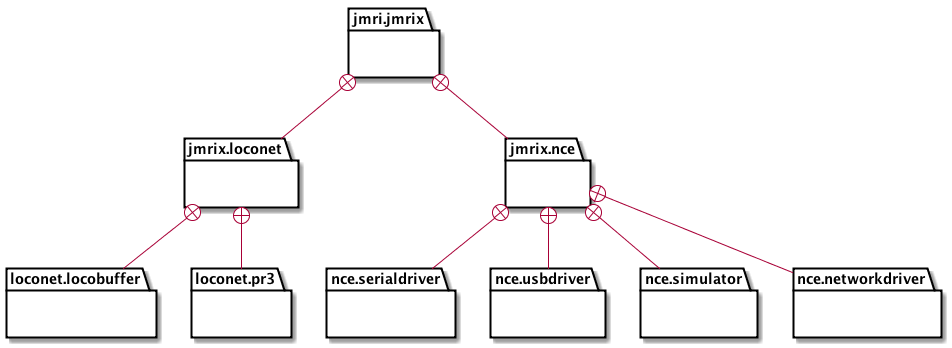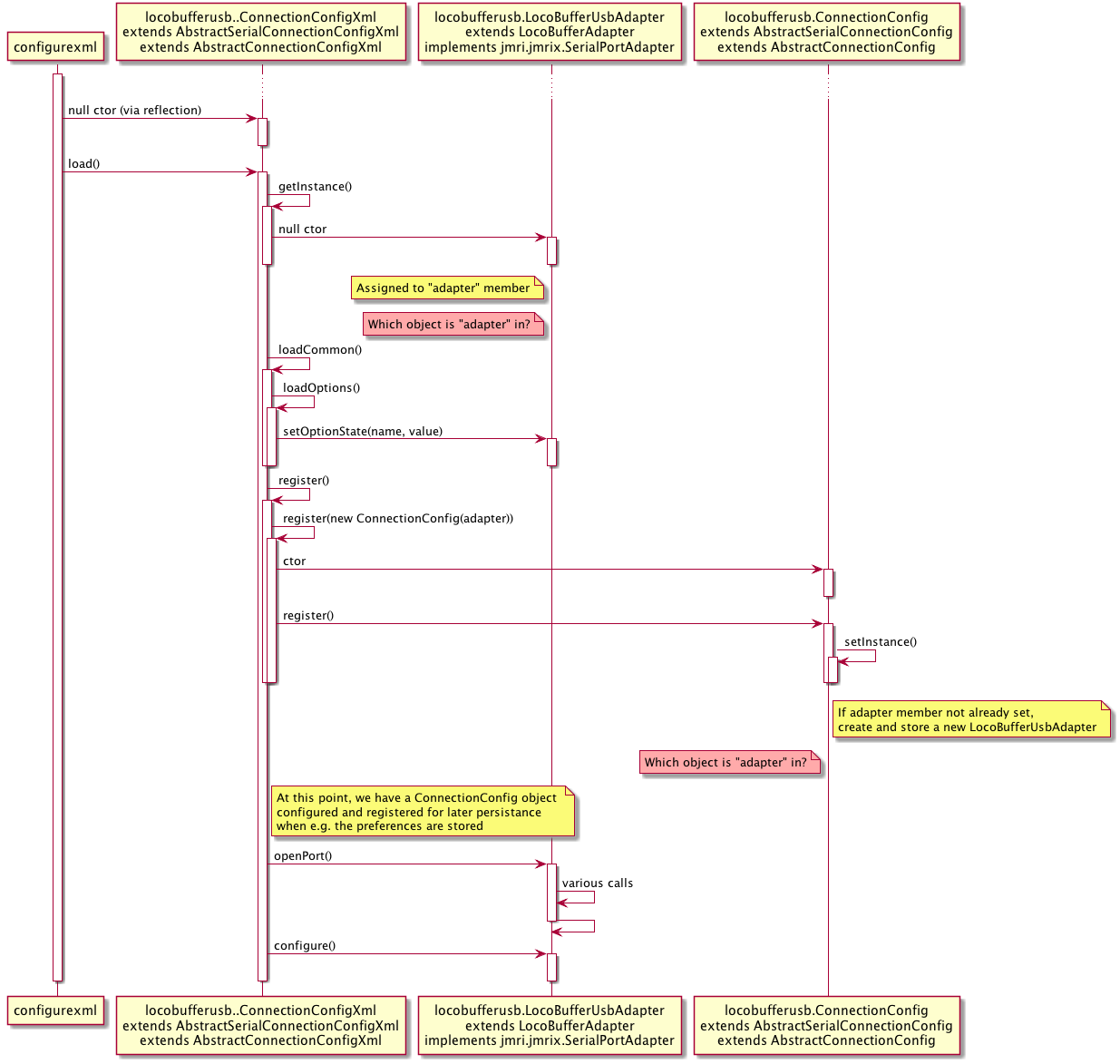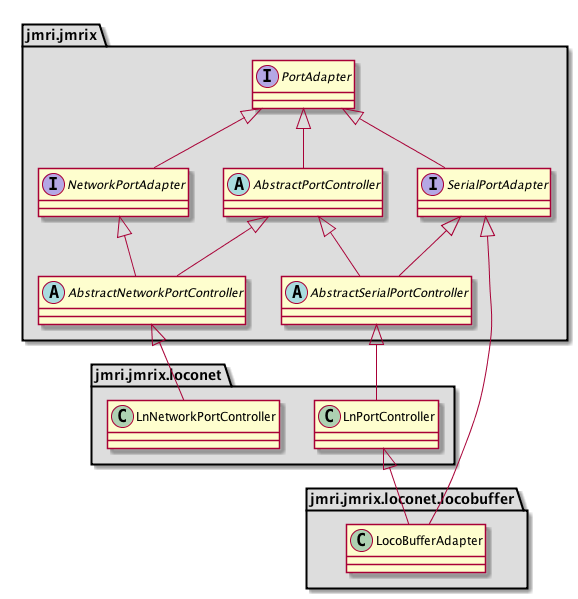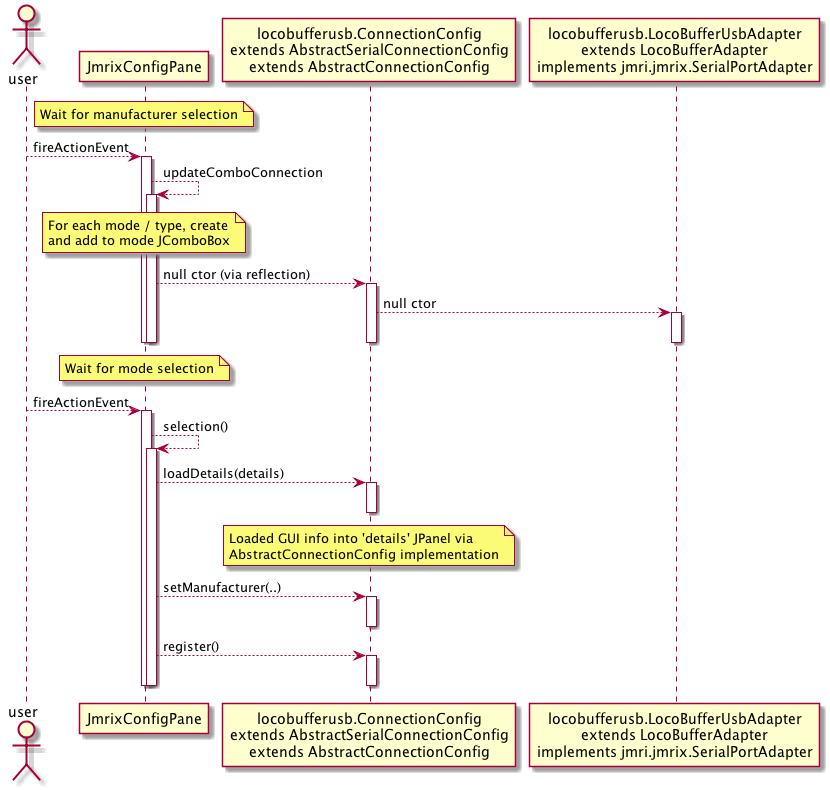- Development Tools
- Code Structure
- Techniques and Standards
- Help and Web Site
- How To
- Functional Info
- Background Info
JMRI Code: Structure of External System Connections
This page is about how JMRI connects to external systems, e.g. DCC systems.
There's a lot of variation within JMRI on this, so you'll have to go through any specific implementation. Specifically, older systems weren't always arranged this way, so existing code may not be a good example.
See also the Multiple Connection Update page.
Code Structure
 The code for a
general type, like "LocoNet connections" or "NCE connections", should be gathered in a
specific package right under
The code for a
general type, like "LocoNet connections" or "NCE connections", should be gathered in a
specific package right under jmri.jmrix e.g.
jmri.jmrix.loconet
and jmri.jmrix.nce.
In the preferences dialog and JmrixConfigPane main configuration code, this
level is called the "manufacturer selection". It provides a level of grouping, which we may
someday want to use for e.g. providing separate updates for specific hardware, while still
separating the system-specific code from the system-independent parts of JMRI.
Within that, the code should be separated further by putting specific hardware options into their own subpackages, for example
jmri.jmrix.loconet.locobuffervsjmri.jmrix.loconet.locobufferusbvs.jmri.jmrix.loconet.pr3vs.jmri.jmrix.loconet.locormijmri.jmrix.nce.serialdrivervs.jmri.jmrix.nce.usbdrivervs.jmri.jmrix.nce.simulatorvs.jmri.jmrix.nce.networkdriver
Additional subpackages can be used grouping various functions as needed. For example, Swing-based tools should go in their own swing subpackage or at a further level within the swing subpackage.
Normal Operation
The key to normal operation (after start up and before shut down) is a SystemConnectionMemo
object that provides all necessary access to the system connection's objects. For example,
the LocoNetSystemConnectionMemo
provides access to a number of LocoNet-specific objects and LocoNet-specific implementations
of common objects. Although some of those (e.g. a SensorManager) might be separately
available from the InstanceManager, accessing them from a SystemConnectionMemo allows you to
find the consistent set associated with one specific connection of a multiple-connection
setup, even when there are multiple connections of a specific type. There are also a few
tools that work with the SystemConnectionManager objects themselves after
obtaining them from the InstanceManager.
Initialization
We don't directly persist the SystemConnectionMemo. This is partly for historical reasons, but it also reflects the level of abstraction: A SystemConnectionMemo is at the level of a "LocoNet connection" or a "NCE connection", and there's a lot of specific information below it to configure one of many possible such connections.
Instead, configuration of the connection is from the bottom up: From the most specific code up to the general. The "Adapter" object connects directly to the system, e.g. managing a serial link, and then builds up the objects that work with that link, including all the various type managers. This makes sense because the type of the connection is really specified via the type of that link and what's on the other end of it.
"Simple" Initialization Sequence
This section describes the LocoNet implementation of the new (post-multiple) configuration system. This is similar for LocoBuffer, LocoBuffer-USB, PR3, etc connections, but we use the specific LocoBuffer-USB case for concreteness. This sequence picks up after the basic startup of the application itself, see the App Structure page for that.
There are several objects involved in startup:
- A
ConnectionConfigXmlobject, created by the ConfigureXML system as part of reading the preferences. It drives the process. - A
ConnectionConfigobject, registered so that a later store of the preferences will write out the right stuff - An
Adapterobject of a very specific type, which handles both the connection to the system hardware, and (through itsconfigure()method) the creation of the rest of the system.
The profile XML file contains a connection element that drives the configuration:
<connection xmlns="" class="jmri.jmrix.loconet.locobufferusb.configurexml.ConnectionConfigXml"
disabled="no" manufacturer="Digitrax" port="/dev/tty.usbserial-LWPMMU13"
speed="57,600 baud" systemPrefix="L" userName="LocoNet">
<options>
<option>
<name>CommandStation</name>
<value>DCS50 (Zephyr)</value>
</option>
<option>
<name>TurnoutHandle</name>
<value>Normal</value>
</option>
</options>
</connection>
 Initialization proceeds through multiple steps (click on the diagram to
expand it):
Initialization proceeds through multiple steps (click on the diagram to
expand it):
- An object of type
jmri.jmrix.loconet.locobufferusb.configurexml.ConnectionConfigXmlis constructed by the configurexml mechanism when the specific class is named by the file during the initial preference load at application startup. - The ConnectionConfigXml object is a child of the jmri.jmrix.configurexml.AbstractSerialConnectionConfigXml class, which is in turn a child of the jmri.jmrix.configurexml.AbstractConnectionConfigXml class.
- After it's constructed, the ConnectionConfigManager calls
load(..)on the ConnectionConfigXml object. This is implemented in jmri.jmrix.configurexml.AbstractSerialConnectionConfigXml which does:- Invoke
getInstance()which initializes anadaptermember implementingSerialPortAdapter. In this case,getInstance()is implemented injmri.jmrix.loconet.locobufferusb.configurexml.ConnectionConfigXmland assigns ajmri.jmrix.loconet.locobufferusb.LocoBufferUsbAdapterto the "adapter" member of "ConnectionConfigXml" That's used later on to configure the port, etc. - Some load of serial port information, e.g. port name and speed values, followed by
calling
loadCommon(shared, perNode, adapter)from the base class, which brings in common information:- Values for four generic options: "option1" through "option4". The port adapters then convert this to specific, connection-specific options as needed later on
- Calls
loadOptions(perNode.getChild("options"), perNode.getChild("options"), adapter)to do any additional handling of info coded in an<options>element. Although overridden in some cases, the default for this is to invokeadapter.setOptionState(name, value)In this LocoNet case, that stores the command station name, see the element above. - Sets a "manufacturer" attribute/name in the TrafficController
- Sets the system prefix and user name in the SystemConnectionMemo
- Sets the adapter disabled or non-disabled
-
register(), which is implemented injmri.jmrix.loconet.locobufferusb.configurexml.ConnectionConfigXmlby invokingthis.register(new ConnectionConfig(adapter)), which in turn is implemented injmri.jmrix.configurexml.AbstractConnectionConfigXmlasprotected void register(ConnectionConfig c) { c.register(); }TheConnectionConfig chere is of typejmri.jmrix.loconet.locobufferusb.ConnectionConfigwhich extendsjmri.jmrix.AbstractSerialConnectionConfigwhich extendsjmri.jmrix.AbstractConnectionConfig.
InAbstractConnectionConfig, finally,register()does:Thatthis.setInstance(); InstanceManager.getDefault(jmri.ConfigureManager.class).registerPref(this); ConnectionConfigManager ccm = InstanceManager.getNullableDefault(ConnectionConfigManager.class); if (ccm != null) { ccm.add(this); }this.setInstance()call is implemented injmri.jmrix.loconet.locobufferusb.ConnectionConfigto set the "adapter" member there to a newLocoBufferUsbAdapterobject. Note that this "adapter" is from the ConnectionConfig (specifically AbstractConnectionConfig) object, not the ConnectionConfigXml object referred to above. In the sequence we're showing here, theLocoBufferUsbAdapterobject had already been created by getInstance inConnectionConfigXml, and passed to theConnectionConfigobject when it's created inside theregister()sequence. At this point, we have ajmri.jmrix.loconet.locobufferusb.ConnectionConfigobject registered for persistence, so it can be written out later. - Initialize the actual port using
adapter.openPort(portName, "JMRI"). This uses code specific to theadaptermember that was initialized ingetInstance(), i.e. in this case LocoBuffer-USB code. - Finally, with the port open and available from the
adapterobject, initialize the operation of the system by callingadapter.configure()method. That Adapterconfigure()method does (through the general LocoBufferAdapter superclass) (this is given as a sample, ignore the details):setCommandStationType(getOptionState(option2Name)); setTurnoutHandling(getOptionState(option3Name)); // connect to a packetizing traffic controller LnPacketizer packets = new LnPacketizer(); packets.connectPort(this); // create memo and load this.getSystemConnectionMemo().setLnTrafficController(packets); this.getSystemConnectionMemo().configureCommandStation(commandStationType, mTurnoutNoRetry, mTurnoutExtraSpace); this.getSystemConnectionMemo().configureManagers(); // start operation packets.startThreads();- The first group does some internal housekeeping and creates the object(s) that run the connection
- The second group loads the previously-created SystemConnectionMemo with
information about the connection.
The
getSystemConnectionMemois in the commonLocoBufferAdaptersuperclass. (There's some code in the inheritance chain that does some casting that should someday be cleaned up) - The third group starts up operation
At this point, the system is basically up and ready for operation.
- Finally, a
jmri.jmrix.loconet.LocoNetSystemConnectionMemoobject is created and registered with the InstanceManager.
- Invoke
- Later,
jmri.jmrix.ActiveSystemsMenuand/orjmri.jmrix.SystemsMenuwill create the main menu bar menus for the individual systems:- Ask the InstanceManager for all the ComponentFactory instances. These were created,
in most cases, in the constructor of the SystemConnectionMemo, and live in the .swing
subproject (e.g.
loconet.swing.LnComponentFactory) - For each of those, ask it for the menu object (e.g.
LocoNetMenu) and post that to the GUI. - In the process of creating the menu, the ComponentFactory connects each Action to itself so that the individual tools will be able to connect to the proper e.g. TrafficController, SlotMonitor, etc.
- When an Action is fired later on, the invoked class(es) inquire of the LocoNetSystemConnectionMemo when they need a resource, instead of referring to an instance() method in the resource's class.
- Ask the InstanceManager for all the ComponentFactory instances. These were created,
in most cases, in the constructor of the SystemConnectionMemo, and live in the .swing
subproject (e.g.
Lessons
Should this part move up?- It's important that managers only be created once. More specifically, the managers and
the SystemConnectionMemo should only be registered in the InstanceManager once. If they're
registered more times than that, they appear as duplicates in various auto-constructed
lists, menus and tab sets.

- Much work is done in the PortAdapter subclasses. From a common
jmrix.PortAdapterinterface, JMRI has two different forms for those:jmrix.SerialPortAdapter(Serial/USB connections) andjmrix.NetworkPortAdapter(network connections).Abstract base classes implement those as
jmrix.AbstractSerialPortController(Serial/USB connections) andjmrix.AbstractNetworkPortController(network connections) (most, but not all, systems use one of those) with a common base ofjmrix.AbstractPortController.These in turn are inherited into the system-specific classes, e.g
loconet.LnPortControllerandloconet.LnNetworkPortControllerrespectively (see UML diagrams on those linked Javadoc pages).Because Java doesn't allow multiple inheritance, the system-specific descendants of the two abstract base classes can't actually share a single common system-specific base class. This results in some code duplication in e.g. serial/USB connections vs the network connection classes in the system-specific classes.
- The terminology switch from "PortAdapter" to "PortController" is confusing. In many
cases, it's
as you work down the abstraction. This should eventually be fixed.
Abstract*PortAdapter <- Sys*PortController <- Sys*PortAdapter - How does
jmrix.AbstractStreamPortControllerfit into thePortAdapterclass hierarchy? (there is no *StreamPortController as defined in its header; it extends AbstractPortController)
- The terminology switch from "PortAdapter" to "PortController" is confusing. In many
cases, it's
More Complex Initialization: C/MRI
For a more complex example, consider C/MRI, which has more content in its
<connection> element:
<connection userName="C/MRI" systemPrefix="C" manufacturer="C/MRI"
disabled="no" port="(none selected)" speed="9,600 baud"
class="jmri.jmrix.cmri.serial.sim.configurexml.ConnectionConfigXml">
<options />
<node name="0">
<parameter name="nodetype">2</parameter>
<parameter name="bitspercard">32</parameter>
<parameter name="transmissiondelay">0</parameter>
<parameter name="num2lsearchlights">0</parameter>
<parameter name="pulsewidth">500</parameter>
<parameter name="locsearchlightbits">000000000000000000000000000000000000000000000000</parameter>
<parameter name="cardtypelocation">1122221112000000000000000000000000000000000000000000000000000000</parameter>
</node>
<node name="1">
<parameter name="nodetype">1</parameter>
<parameter name="bitspercard">24</parameter>
<parameter name="transmissiondelay">0</parameter>
<parameter name="num2lsearchlights">0</parameter>
<parameter name="pulsewidth">500</parameter>
<parameter name="locsearchlightbits">000000000000000000000000000000000000000000000000</parameter>
<parameter name="cardtypelocation">2210000000000000000000000000000000000000000000000000000000000000</parameter>
</node>
<node name="2">
<parameter name="nodetype">2</parameter>
<parameter name="bitspercard">32</parameter>
<parameter name="transmissiondelay">0</parameter>
<parameter name="num2lsearchlights">0</parameter>
<parameter name="pulsewidth">500</parameter>
<parameter name="locsearchlightbits">000000000000000000000000000000000000000000000000</parameter>
<parameter name="cardtypelocation">2212120000000000000000000000000000000000000000000000000000000000</parameter>
</node>
<node name="4">
<parameter name="nodetype">1</parameter>
<parameter name="bitspercard">24</parameter>
<parameter name="transmissiondelay">0</parameter>
<parameter name="num2lsearchlights">0</parameter>
<parameter name="pulsewidth">500</parameter>
<parameter name="locsearchlightbits">000000000000000000000000000000000000000000000000</parameter>
<parameter name="cardtypelocation">2210000000000000000000000000000000000000000000000000000000000000</parameter>
</node>
</connection>
How this gets read in.
Implications for internal structure.
Proper internal structure
Configuration Process
See jmrix.JmrixConfigPane Javadoc for links to configuration elements. (Is there another place that the configuration process and preferences support is described? If so, it should be linked from here.)
Any particular system connection is included in the preferences by being listed in the
java/src/META-INF/services/jmri.jmrix.ConnectionTypeList list. This file is
normally generated from the @ServiceProvider(service = ConnectionTypeList)
class-level annotations.
Any particular system connection is included in the preferences by
being listed in the target/classes/META-INF/services/jmri.jmrix.ConnectionTypeList list. This file is normally
generated from the @ServiceProvider(service = ConnectionTypeList) class-level annotations.
# Providers of System Connections type lists in Preferences
# Order is Insignificant
jmri.jmrix.internal.InternalConnectionTypeList
jmri.jmrix.lenz.LenzConnectionTypeList
...
jmri.jmrix.loconet.LnConnectionTypeList
...
This provides the contents for the 1st-level selection in the top JComboBox, e.g. in
this case "Digitrax". This (generally) corresponds to selecting a system package within the JMRI
package that might contain multiple variants of a specific connection. Within
JmrixConfigPane this is called the "manufacturer" selection.
The contents of the
jmri.jmrix.loconet.LnConnectionTypeList, an instance of jmri.jmrix
.ConnectionTypeList then provides the contents for the second-level JComboBox of
specific connection types, each corresponding (generally) to a specific
ConnectionConfig implementation that can configure a specific connection type.
Within JmrixConfigPane this is called the "mode" selection.
Creating from scratch
 Note this starts off by creating a ConnectionConfig, which
creates a PortAdapter, similar to the read-from-XML version. But we don't want a running
connection: We want one that we can work with to set/store configuration information. So,
although we "register()", we do not "configure()".
Note this starts off by creating a ConnectionConfig, which
creates a PortAdapter, similar to the read-from-XML version. But we don't want a running
connection: We want one that we can work with to set/store configuration information. So,
although we "register()", we do not "configure()".
Filling the details JPanel is done within the ConnectionConfig
object via a call to loadDetails(). In many cases, including this LocoNet
example, that's referred up to a base class:
-
AbstractSerialConnectionConfighandles connections through serial links that need specification of serial port name, baud rate, etc. -
AbstractNetworkConnectionConfighandles connections through network (TCP) connections that need specification of network address, port, etc. -
AbstractStreamConnectionConfighandles configuration of connections based on streams. -
AbstractSimulatorConnectionConfighandles configuration of simulated connections.
Storing
Changing Options
The Swing panel that shows the main options (e.g. option1 through option4) sets changes to those values directly into the ConnectionConfig/PortAdapter without asking them to act further via e.g. configure().Updating a Connection Mode
Changing the mode JComboBox inJmrixConfigPane first clears the existing
contents of the details JPanel with removeAll(), then calls the
JmrixConfigPane.selection() method to refill it.
Deleting a Connection
Misc
This section is a grab-bag of other things you might want to know about the system connection structure.- The
jmri.swing.ConnectionLabelclass is a Swing JLabel that listens to a single connection and displays its status. We use those on the main splash screen, but they can also be used in other places.